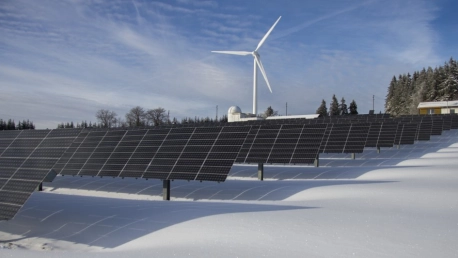The information and communication technology (ICT) sector consumes 1.8% to 3.9% of global greenhouse gas emissions, according to research by IBM. As computing advances, so will the demand for energy consumption, however, data centers must adopt strategic green computing practices to minimize usage. Organizations can implement eco-friendly solutions for every aspect of their computing devices and related resources, including manufacturing, design, disposal, and operations.
This guide will explore green computing, and how strategies such as tracking and monitoring energy levels, smart design layouts, automation technologies, modern systems, and valuable partnerships can help businesses support the environment.
What Is Green Computing?
Green computing, or green technology, describes the eco-friendly use of computers and their components. It refers to the study, design, development, and implementation of computing technologies in a way that optimizes their environmental impact and promotes sustainability.
Here is an overview of the sustainability standards organizations must adopt in every aspect of their computing:
Operations
- Reduce the energy used by office equipment.
- Turn off computers at the end of each day.
- Computers set to enter hibernation or sleep mode if the user is away for an extended period.
Design
- Develop an eco-friendly design strategy for computing devices, such as computers, printers, servers, and similar digital devices—which is known as green design.
- Evaluate the device’s longevity, size, modularity, end of life (EOL), and packaging and ensure all these stages leverage eco-friendly solutions.
Disposal
- Implement environmentally sustainable disposal strategies for computing devices—this process is called e-waste management.
- Repurpose office equipment.
- Work with a certified recycling partner.
Manufacturing
- Minimize their waste and energy consumption when manufacturing computers and related electronic devices—known as green manufacturing.
- Consider bamboo materials or similar eco-friendly solutions for computer cases. Use recyclable plastics throughout the manufacturing process, and eco-friendly flame retardants.
By implementing the framework above, organizations can deploy eco-friendly solutions to optimize every aspect of their use of computing devices and resources.
The Top 5 Green Computing Strategies
Track and Monitor Base Energy Usage
Organizations must determine their current base energy usage to begin a green computing strategy. Businesses must identify the energy usage for specific computing devices and processes, including servers, computers, network infrastructure, HVAC, and data storage. With these energy consumption insights, organizations can identify which aspects must be optimized and set realistic goals to achieve computing sustainability.
Case Study: Automobile Factory
An automobile business used a monitoring and tracking strategy to minimize computing energy consumption. The installed energy management system relied on a huge network of hardware and software components to extract real-time energy usage data. In addition, the system could:
- Monitor the power quality for each department.
- Generate monthly energy levels and bills.
- Provide warning signals when departments exceeded their usage limit.
- Remotely control the main circuit breakers for each department to detect abnormal activity.
- Maintain a database of energy consumption.
Moreover, because their energy monitoring and tracking program evaluated in-depth consumption, the automobile store had a robust insight into how they could adapt their computing and save energy.
As a result of tracking their energy levels, this company could reduce annual energy costs by 7.75%, and after 28 months, they earned the initial investment expense.
Leverage Smart Design Layouts
The purpose of smart design layouts for data centers is to optimize their physical infrastructures to improve power efficiency and reduce their total cost of ownership (TCO) for energy consumption. In addition, this modular approach will help organizations avoid system outages and downtimes while minimizing their carbon footprint.
As modular data centers are developed offsite, businesses can rely on smooth integration without constructing these infrastructures. Smart layouts reduce data center costs in many aspects including, construction, maintenance, testing, installation, and expansion.
Case Study: Google
As Google’s data centers manage increasingly high volumes of information, this tech giant made several optimizations to their networking rooms to reduce energy consumption. First, they measured their energy consumption levels to pinpoint the best adjustments. While Google did not want to make large-scale capital improvements, they aimed to maximize the efficiency of the existing equipment and infrastructure. To achieve this, Google did the following:
- Implement critical monitoring points (CMPs) to monitor and stay ahead of energy consumption readings.
- Move air vent tiles to the area with the most heat, which they could identify due to their CMPs.
- Based on ASHRAE’s recommended temperature for data centers, they adjusted the room temperature to a maximum of 81°/ 27 °C while maintaining humidity between 20% and 80%.
- Develop containment curtains to isolate the UPS and prevent it from overheating.
Based on the above adaptions, Google decreased their per-watt energy usage by a third and saved 670 MWh, which equates to a $67,000 savings in yearly energy costs.
Replace or Repurpose Outdated Systems
Legacy systems often have high energy consumption, significant costs and generate more heat. However, by repurposing or replacing these systems, data centers can minimize their carbon footprint and promote eco-friendly practices. For instance, organizations can replace physical data storage with cloud technology. The aim is to find eco-friendly, modern solutions to replace inefficient systems with high energy usage.
Case Study: E.ON
E.ON, approached Google Cloud to help them migrate their physical network infrastructure to the cloud and optimize energy consumption. In addition, E.ON had over 50,000 customers in their network and wanted to give these users more control over their usage, requiring the company to find solutions for data efficiency too.
Helping E.ON accomplish their sustainability and data management goals, Google Cloud developed a cloud computing infrastructure, offering both scalability and automation. After four months of adapting to Google Cloud, E.ON achieved the following results:
- 99.9% system availability, which means no outages or downtime.
- Real-time consumption analytics to minimize their carbon footprint.
- Automated workflows to reduce internal efforts and maximize energy usage.
- Automatically scale and deploy data analytics to over 10,000 customers through Google Kubernetes Engine.
Invest In Smart Management Technology
Data centers handle large volumes of information and must invest in AI technology for automated management to streamline these processes. These tools will leverage machine learning (ML) to help organizations analyze data related to their sustainability while extracting actionable insights to optimize their eco-friendly strategies.
For instance, AI management software can analyze the total HVAC consumption and identify ways to reduce it. In addition, platforms will automatically optimize HVAC systems, maintain a consistent temperature and ensure heat reduction.
Case Study: Huawei
Huawei began an initiative to transform all its data centers for sustainability and invested in AI management solutions accordingly. First, the multinational technology corporation used machine learning (ML) to develop the iCooling intelligent thermal management solution.
The iCooling system relies on deep learning (DL) to analyze current and historical data and identify facts affecting energy efficiency while producing a power usage effectiveness (PUE) prediction. In addition, Huawei developed the iPower intelligent power supply and distribution technology to detect and isolate energy efficiency faults.
iPower could minimize the risk of outages and shutdowns and offer predictive maintenance to optimize data center infrastructure lifespan. However, Hauweir took this initiative further and developed the iManager infrastructure management system. Using this technology, Huawei could use AI hardware and sensors to manage cooling and data storage, power, and the allocation and operation of computing resources and assets.
Credited to the use of AI for energy efficiency, Hauwei accomplished the following among their data centers:
- PUE ratio of 1.15 in their Ulanqab data center.
- Reduced the PUE ratio by 8% in their Langfang, China data center.
- Reduced total energy consumption by 3.2% in their Ningxia location, saving 400,000 kWh every year.
- Increased resource utilization rate by 20%.
Work with Green IT Organizations and Suppliers
One of the most effective ways to increase and promote sustainability is by working with green organizations and vendors. Data centers must opt for partners who produce, promote, or provide sustainable solutions for green computing. For instance, if data centers need suppliers for electronic equipment or services to dispose of their waste through eco-friendly methods, they can consider networks such as RE100 and CPD.
In addition, many eco-friendly certification programs are available to organizations. They can access networks of sustainable vendors and partners—such as The Green Business Bureau, USDA Organic, and LEED. Not only will these programs help data centers network with green companies, but achieving a sustainability certification is an excellent way to share this movement with customers and other organizations in the industry.
Case Study: Airtel
Airtel, a telecommunications company in India, experienced the challenge of rising network traffic equating to significant energy consumption. The company had to ensure its mix of data centers could adopt sustainable practices while scaling to the demand of its users. Fortunately, Airtel developed partnerships with numerous eco vendors and organizations, which included the following:
- Amp Energy: Developed a partner with Amp Energy to commission a photovoltaic asset in their Uttar Pradesh data centers—they secured a 26% stake in this company.
- Power Purchase Agreement (PPA). Airtel signed a PPA to source electricity from a 9 MW hydropower plant to its Delhi data centers.
- Avaada Energy: To source solar power from a 65 MW photovoltaic asset, Airtel also secured a partnership with Avaada Energy, which has mitigated over 8.3 metric tons (MT) of CO2.
In Closing
With these five strategies for green computing, data centers can leverage eco-friendly solutions for all aspects of computing devices—operations, design, disposal, and manufacturing. To start, organizations must track and monitor their energy usage, and then they will have the insights to adopt smart design layouts, replace legacy systems and implement AI. In addition, data centers should partner with eco-friendly vendors and businesses to scale while promoting sustainability.









